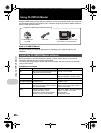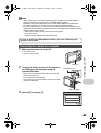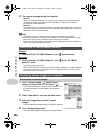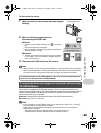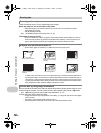
EN
53
Getting to know your camera better
The flash is activated automatically when there is insufficient light, or when the camera is
shaken. To take pictures with no flash in dark places, set the flash mode to [$] and set as
follows:
Increase the [ISO] setting
g “ISO Changing the ISO sensitivity” (P. 28)
There are several factors that can cause the picture to appear grainy.
Using the digital zoom to take close-up pictures
• With the digital zoom, part of the image is cropped and enlarged. The greater the
magnification, the grainier the picture appears.
g “DIGITAL ZOOM Zooming in on your subject” (P. 29)
Increasing the ISO sensitivity
• When you increase the [ISO] setting, “noise”, which appears as spots of unwanted color or
unevenness in the color, can be introduced and give the picture a grainy appearance. This
camera is equipped with a function to allow shooting at high sensitivity while suppressing
noise; however, increasing the ISO sensitivity can result in some noise, depending on the
shooting conditions.
g “ISO Changing the ISO sensitivity” (P. 28)
• The reason why there are sometimes differences between the actual colors and the colors
recorded in a picture is related to the light source illuminating the subject. [WB] is the
function that helps the camera determine the true colors. Normally, the [AUTO] setting
provides the optimal white balance, but depending on the subject, results may be better if
you manually adjust the [WB] setting.
• When the subject is in the shade on a sunny day
• When the subject is illuminated by both natural light and indoor lighting, such as when
near a window
• When there is no white in the center of the frame
g “WB Adjusting the color of a picture” (P. 28)
• Take pictures with K in s mode. Suitable for taking pictures on a sunny day at the
beach or in the snow.
g “s (Scene) Selecting a scene mode according to the shooting situation” (P. 27)
• Often, bright subjects (such as snow) turn out darker than their natural colors. Use 1F to
adjust toward [+] to make these subjects closer to their true shades. Conversely, when you
are shooting dark subjects, it can be effective to adjust toward the [–]. Sometimes, using the
flash may not produce the brightness (exposure) that was intended.
g “1F button Changing picture brightness (Exposure Compensation)” (P. 17)
• Panning along the camera central axis reduces picture misalignment. When you shoot close
subjects, panning along the axis of the lens gives good results.
• In [COMBINE IN CAMERA1] mode, the camera automatically detects its own position
except for the following cases (In such cases, use [COMBINE IN CAMERA 2] or [COMBINE
IN PC].):
• when panning the camera in a quick or unsteadily manner.
• when shooting a low contrast subject (blue sky, etc.).
• when shooting a moving subject framed in full screen.
• when panning the camera with no images on-screen.
Taking stabilized pictures without the flash
The picture is too grainy
Taking pictures with the correct color
Taking pictures of a white beach or snow scene
Misalignment of panoramic pictures
d4361_e_0000_7.book Page 53 Monday, November 5, 2007 3:34 PM




